
Network Railcard
Encyclopedia
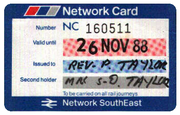
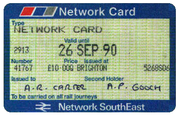

British Rail
British Railways , which from 1965 traded as British Rail, was the operator of most of the rail transport in Great Britain between 1948 and 1997. It was formed from the nationalisation of the "Big Four" British railway companies and lasted until the gradual privatisation of British Rail, in stages...
, upon the creation of their Network SouthEast
Network SouthEast
Network SouthEast was one of three passenger sectors of British Rail created in 1982. NSE principally operated commuter trains in the London area and inter-urban services in densely populated South East England, although the network reached as far west as Exeter...
area around London
London
London is the capital city of :England and the :United Kingdom, the largest metropolitan area in the United Kingdom, and the largest urban zone in the European Union by most measures. Located on the River Thames, London has been a major settlement for two millennia, its history going back to its...
, England
England
England is a country that is part of the United Kingdom. It shares land borders with Scotland to the north and Wales to the west; the Irish Sea is to the north west, the Celtic Sea to the south west, with the North Sea to the east and the English Channel to the south separating it from continental...
.
The card is intended to encourage leisure travel by rail by offering discounts for adults and accompanying children on a wide range of off-peak fares. The range of discounts available, and the price of the card, have varied since that time, but the card has always been valid for a year's unlimited use.
It can be purchased by any person aged 16 or over from any staffed National Rail station or Rail Appointed Travel Agent, by completing an application form - no photographic identification or other documentation is needed to buy or use the card. It is one of a number of concessionary fare schemes available on the British railway system
Concessionary fares on the British railway network
In addition to the large number and variety of short-term or localised promotional fares that have been available to passengers on the British railway network in recent decades , there are many permanent concessionary fare schemes available to passengers...
.
History
The Network SouthEast brand was introduced to what had been the London & South East sector of British Rail on 10 June 1986. The railcard was then introduced on 29 September 1986, under the name Network Card. It offered a 34% discount on all off-peak fares for journeys wholly within the Network SouthEast area. Tickets valid at peak times, such as Day Returns and Open Returns, were excluded, as were First Class tickets (however, a supplement ticket could be bought to upgrade a discounted Standard Class ticket to First Class at weekends). On weekdays, journeys had to start after 10.00am, but there were no time restrictions at weekends or on Bank HolidayBank Holiday
A bank holiday is a public holiday in the United Kingdom or a colloquialism for public holiday in Ireland. There is no automatic right to time off on these days, although the majority of the population is granted time off work or extra pay for working on these days, depending on their contract...
s. Up to three adults could accompany the railcard holder and gain the same discount, while up to four accompanying children could travel for a £1.00 flat fare. This version of the railcard could be issued for either one person or two people. On a two-person "joint-holder" ticket, either or both of the named holders could travel - that is, the card was transferable between the two.
The first major change was made as from 28 September 1997. At this time, the name Network Railcard was adopted; the joint-holder option was removed; the price was increased to £20.00; and the First Class supplement facility was discontinued. All other benefits remained the same, however. New ticket stock was introduced with APTIS
APTIS
APTIS was the Accountancy and Passenger Ticket Issuing System used on Rail transport in Great Britain until 2007.It was widely known as the All-Purpose Ticket-Issuing System, a description which was used during the development of the...
form number RSP 4599/188 (the Network Card was BR 4599/22 and, after privatisation, RSP 4599/22).
A larger and more controversial change occurred as from 2 June 2002, when the discount level was changed: a minimum adult fare of £10.00 was imposed for weekday journeys, and children now received an 81% discount on the full adult fare (equivalent to a 60% on the full child fare, and subject to a minimum fare of £1.00) instead of the former £1.00 flat fare for all journeys. This meant that on a weekday, holders would receive no discount if the standard adult full fare was £10.00 or less, and a discount of less than 34% on fares between £10.05 and £15.00. Longer journeys for children would also become more expensive. Transport pressure group Transport 2000
Transport 2000
The Campaign for Better Transport is a UK advocacy group that promotes better bus and rail services and for supportive policies and for less expenditure on road building...
and environmental organisation Friends of the Earth
Friends of the Earth
Friends of the Earth International is an international network of environmental organizations in 76 countries.FOEI is assisted by a small secretariat which provides support for the network and its agreed major campaigns...
condemned the proposals, and Reading East MP
Reading East
Reading East is a borough constituency represented in the House of Commons of the Parliament of the United Kingdom. Like all such constituencies, it elects one Member of Parliament by the first past the post system of election...
Jane Griffiths
Jane Griffiths (politician)
Jane Patricia Griffiths is a British linguist and politician. She held positions as a Labour councillor on Reading Borough Council, and as Labour Member of Parliament for the Reading East parliamentary constituency...
tabled an Early Day Motion
Early day motion
An Early Day Motion , in the Westminster system, is a motion, expressed as a single sentence, tabled by Members of Parliament for debate "on an early day" . Controversial EDMs are not signed by Government Ministers, PPS or the Speaker of the House of Commons and very few are debated on the floor...
in the British Parliament opposing the changes. This gained the support of 38 other MPs from all major parties. Research commissioned by Transport 2000 indicated that 90% of journeys typically made in the railcard area would no longer gain any discount (as a result of the full adult fare being £10.00 or below), a further 3.5% would attract a discount of less than 34%, and only 6.5% would still be subject to the full 34% discount as before. This reflects the fact that many journeys undertaken in the area are short and "local" in nature, and that the area as a whole is fairly small in size (as the map shows, it does not extend a very long way from London in any direction).
To compensate for the problems and disruption experienced on the railway network between 2000 and 2002, Network Railcards bought in the early months of 2002 (until 18 May 2002) were issued for 15 months for the price of 12.
In May 2009 the Network Railcard terms were revised again, making the card both more expensive and raising the minimum fare for a discount to £13.00.
Tickets issued with Network Cards/Railcards
On the APTISAPTIS
APTIS was the Accountancy and Passenger Ticket Issuing System used on Rail transport in Great Britain until 2007.It was widely known as the All-Purpose Ticket-Issuing System, a description which was used during the development of the...
, PORTIS/SPORTIS
PORTIS/SPORTIS
PORTIS and latterly SPORTIS were portable ticket issuing systems used on Rail transport in Great Britain until 2006...
and other computerised ticket issuing systems, a "status code" field is provided on each ticket issued. This is left blank if an adult is travelling at full (undiscounted) fare; but if any discount or other special condition applies, a code of up to five letters appears.
Adult tickets issued with the original Network Card displayed a status code of NSE, while child tickets showed CHNSE. These codes continued in use when the Network Railcard was introduced in its place, until the major change in June 2002. When the "new" Network Railcard was introduced, with the £10.00 minimum fare and altered child discount, there were still a large number of "old" Network Railcards in use, with no minimum fare restriction and £1.00 flat fares for children. A method of distinguishing these on tickets had to be developed. ATOC introduced the following codes accordingly, and uploaded them to all ticket issuing systems in mid-2002:
- "Old" Network Railcard adult fare: NR01A
- "Old" Network Railcard child fare: NR01C
- "New" Network Railcard adult fare: NR02A
- "New" Network Railcard child fare: NR02C
By August 2003 (18 May 2002 + 15 months), no "old" Network Railcards remained in use, and ATOC eventually stopped using the new codes on ticket issuing systems, reverting to NSE and CHNSE instead; however, the codes NR02A and NR02C are still used in paper and online forms of the National Fares Manuals
UK railway technical manuals
The railway network of Great Britain is operated with the aid of a number of documents, which have been sometimes termed "technical manuals", because they are more detailed than the pocket-timetables which the public encounters every day...
issued to the Train Operating Companies, Rail Appointed Travel Agents and other ticket-issuing locations.
| Adult status codes | Child status codes |
|---|---|
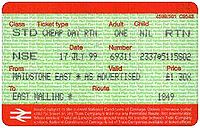 |
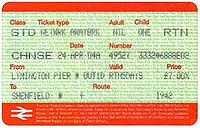 |
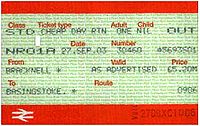 |
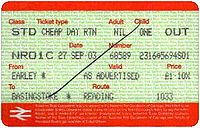 |
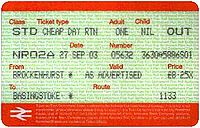 |
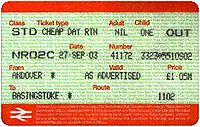 |
Price
The price of the railcard increased over the years, and different prices were sometimes charged for "joint holder" status and according to whether Senior Railcards or Young Persons Railcards were held as well.| Effective from | Single-holder railcard |
When bought by Young Persons Railcard holder |
When bought by Senior Railcard holder |
Joint-holder railcard |
When bought by Young Persons Railcard holder |
When bought by Senior Railcard holder |
|---|---|---|---|---|---|---|
| 29 September 1986 | £10.00 | N/A | £5.00 | £10.00 | N/A | £5.00 |
| 1 March 1987 | £10.00 | £5.00 | £5.00 | £10.00 | £5.00 | £5.00 |
| 12 May 1991 | £12.00 | £8.00 | £8.00 | £15.00 | £10.00 | £10.00 |
| 29 May 1994 | £14.00 | £10.00 | £10.00 | £17.00 | £12.00 | £12.00 |
| 28 September 1997 | £20.00 | N/A | N/A | N/A | N/A | N/A |
| 17 May 2009 | £25.00 | N/A | N/A | N/A | N/A | N/A |
.jpg)
Slough
Slough is a borough and unitary authority within the ceremonial county of Royal Berkshire, England. The town straddles the A4 Bath Road and the Great Western Main Line, west of central London...
, and carried an endorsement on the reverse to show which type of reduction applied.
First Class supplement upgrade tickets were initially priced at a flat fare of £1.00 for both adults and children for any length of journey. This became £3.00 for adults and £1.50 for children in February 1990. The benefit was withdrawn upon the introduction of the first Network Railcard on 28 September 1997.
Gold card discount (season tickets)
Holders of annual season tickets for journeys within the Network Rail area, including on London Underground, are issued with a "Gold Card" which gives them similar privileges to the Network Railcard, as well as being able to purchase a Network Railcard for a friend or family member for a discounted price of £1.00 There is also no minimum fare for "Gold Card" discounts, and the ability to upgrade to first class for a flat fare also remains. This includes cases where the annual season ticket is applied to an Oyster card
Oyster card
The Oyster card is a form of electronic ticketing used on public transport services within the Greater London area of the United Kingdom. It is promoted by Transport for London and is valid on a number of different travel systems across London including London Underground, buses, the Docklands...
.
Popularity
When the Network Card was introduced, it quickly became popular with the public: more than 500,000 were sold per year at first, and a noticeable increase was achieved in the use of the rail network at off-peak times for leisure purposes. Although ownership had declined to around 360,000 by the time of the £10.00 minimum fare change in 2002, extra ticket sales totalling approximately £70 million were still generated per year. (For comparison, total ticket sales across the whole British railway network, including all peak, off-peak and other tickets, are approximately £3.5 billion.) Ownership of railcards has stayed fairly stable since then; and with 360,000 sold at £20 each (£28 in 2011), sales of the railcards themselves bring in more than £7 million per year, before the additional revenue from journeys made with them is taken into account.Network Railcard area
The Railcard scheme is administered by the Association of Train Operating CompaniesAssociation of Train Operating Companies
The Association of Train Operating Companies is a body which represents 24 train operating companies that provide passenger railway services on the privatised British railway system. It owns the National Rail brand. The Association is an unincorporated association owned by its members...
(ATOC) on behalf of the following Train Operating Companies (TOCs), some or all of whose services are within the boundaries of the railcard area:
| Valid on all services |
|
|---|---|
| Valid on services within boundaries of railcard area |
Chiltern Railways Chiltern Railways is a British train operating company. It was set up at the privatisation of British Rail in 1996, and operates local passenger trains from Marylebone station in London to Aylesbury and main-line trains on the Chiltern Main Line to Birmingham Snow Hill with its associated branches... CrossCountry CrossCountry is the brand name of XC Trains Ltd., a British train operating company owned by Arriva... First Capital Connect First Capital Connect is a passenger train operating company in England that began operations on the National Rail network on 1 April 2006... First Great Western First Great Western is the operating name of First Greater Western Ltd, a British train operating company owned by FirstGroup that serves Greater London, the South East, South West and West Midlands regions of England, and South Wales.... East Midlands Trains East Midlands Trains is a British passenger train operating company. Based in Derby, it provides train services in the East Midlands, chiefly in the counties of Lincolnshire, South Yorkshire, Nottinghamshire, Leicestershire, Derbyshire and Northamptonshire, and between the East Midlands and London... London Midland London Midland is a train operating company in the United Kingdom. Legally named London and Birmingham Railway Ltd, it is a subsidiary of Govia, and has operated the West Midlands franchise since 11 November 2007.... South West Trains South West Trains is a British train operating company providing, under franchise, passenger rail services, mostly out of Waterloo station, to the southwest of London in the suburbs and in the counties of Surrey, Hampshire, Dorset, Devon, Somerset, Berkshire, and Wiltshire and on the Isle of Wight... Virgin Trains Virgin Trains is a train operating company in the United Kingdom. It operates long-distance passenger services on the West Coast Main Line between London, the West Midlands, North West England, North Wales and Scotland... |
Original area
When Network SouthEastNetwork SouthEast
Network SouthEast was one of three passenger sectors of British Rail created in 1982. NSE principally operated commuter trains in the London area and inter-urban services in densely populated South East England, although the network reached as far west as Exeter...
was created in 1986, its boundaries represented the boundaries of the railcard area. Since then, some small extensions have been made. The original boundaries were:
- The West of England Main LineWest of England Main LineThe West of England Main Line is a British railway line that runs from , Hampshire to Exeter St Davids in Devon, England. Passenger services run between London Waterloo station and Exeter...
, as far south as WhimpleWhimple railway stationWhimple railway station serves the village of Whimple in East Devon, Devon, England. It was opened by the London and South Western Railway in 1860 but is now operated by South West Trains which provides services on the London Waterloo to Exeter route....
- see the exception below - BedwynBedwyn railway stationBedwyn railway station is a railway station in the village of Great Bedwyn, Wiltshire, England. It is also, along with , a station for the market town of Marlborough away...
on the Great Western Main LineGreat Western Main LineThe Great Western Main Line is a main line railway in Great Britain that runs westwards from London Paddington station to the west of England and South Wales. The core Great Western Main Line runs from London Paddington to Temple Meads railway station in Bristol. A major branch of the Great... - The route from ReadingReading railway stationReading railway station is a major rail transport hub in the English town of Reading. It is situated on the northern edge of the town centre, close to the main retail and commercial areas, and also the River Thames...
to BanburyBanbury railway stationBanbury railway station serves the town of Banbury in Oxfordshire, England. The station is currently operated by Chiltern Railways, on the Chiltern Main Line, and has four platforms in use.-History:...
, incorporating the Cherwell Valley LineCherwell Valley LineThe Cherwell Valley Line is the railway line between Didcot and Banbury via Oxford. It links the Great Western Main Line and the south to the Chiltern Main Line and the Midlands... - NorthamptonNorthampton railway stationNorthampton railway station is a railway station serving the large town of Northampton and other parts of Northamptonshire in England. Other parts of South Northamptonshire are better served by Kings Sutton, Banbury and Milton Keynes Central stations....
on the West Coast Main LineWest Coast Main LineThe West Coast Main Line is the busiest mixed-traffic railway route in Britain, being the country's most important rail backbone in terms of population served. Fast, long-distance inter-city passenger services are provided between London, the West Midlands, the North West, North Wales and the... - Bedford on the Midland Main LineMidland Main LineThe Midland Main Line is a major railway route in the United Kingdom, part of the British railway system.The present-day line links London St...
- HuntingdonHuntingdon railway stationHuntingdon Railway Station serves the town of Huntingdon in Cambridgeshire. The station is on the East Coast Main Line and has three platforms; one bay and two through platforms...
on the East Coast Main LineEast Coast Main LineThe East Coast Main Line is a long electrified high-speed railway link between London, Peterborough, Doncaster, Wakefield, Leeds, York, Darlington, Newcastle and Edinburgh... - King's LynnKing's Lynn railway stationKing's Lynn railway station serves the town of King's Lynn in Norfolk. The station is the terminus of the Fen Line from Cambridge, which is electrified at 25 kV AC overhead...
on the Fen LineFen LineThe Fen Line is a railway in the United Kingdom that runs between the cities of Cambridge, Cambridgeshire and King's Lynn, Norfolk; the line is so called because it runs through The Fens. The line is part of the Network Rail Strategic Route 5 and comprises SRS 05.06 and part of 05.05... - ManningtreeManningtree railway stationManningtree is a railway station which serves the town of Manningtree in Essex, England. Services are provided by National Express East Anglia. The station is on the Great Eastern Main Line between London and Norwich and is the only station on the main line between Colchester and Ipswich....
on the Great Eastern Main LineGreat Eastern Main LineThe Great Eastern Main Line is a 212 Kilometre major railway line of the British railway system, which connects Liverpool Street in the City of London with destinations in east London and the East of England, including Chelmsford, Colchester, Ipswich, Norwich and several coastal resorts such as... - The Harwich branch line (Mayflower LineMayflower LineThe Mayflower Line is a branch railway line from Manningtree to Harwich in the county of Essex in England. Passenger services are operated by National Express East Anglia...
) from Manningtree to Harwich TownHarwich Town railway stationHarwich Town is a railway station which serves the town of Harwich, in Essex, England. The station, and all trains serving it, are operated by National Express East Anglia...
All other main lines and branches south and east of these were included, except the Gatwick Express
Gatwick Express
Gatwick Express is the name given to the frequent rail shuttle service between Victoria station in London and Gatwick Airport in South East England, operated by the Southern franchise...
service between London Victoria and Gatwick Airport.
The exception on the West of England Main Line related to tickets issued from or to Pinhoe
Pinhoe railway station
Pinhoe railway station is a railway station on the eastern edge the city of Exeter, Devon, England, that serves the village of Pinhoe. It was opened by the London and South Western Railway in 1871 but is now operated by South West Trains which provides services on the London Waterloo to Exeter...
, Exeter Central
Exeter Central railway station
Exeter Central railway station is the most centrally located of the railway stations in Exeter, Devon, England. It is smaller than St Davids which is on the west side of the city but it is served by trains on the London Waterloo to Exeter main line, and is also by local services to , and . From...
and Exeter St Davids
Exeter St Davids railway station
Exeter St Davids station is the most important of seven National Rail stations in the city of Exeter in southwest England. Today the station is owned by Network Rail and operated by First Great Western.-History:...
stations. Discounted tickets could be bought to or from these stations provided they were not for journeys to, from or via London or Reading. This is because an alternative route (via Westbury
Westbury railway station
Westbury railway station serves the town of Westbury, Wiltshire, England. The station is managed by First Great Western.The station is a major junction, serving the Reading to Plymouth Line with services to and from Penzance and London Paddington, the Wessex Main Line with services to and from...
) was (and still is) available from Exeter to London and Reading; it was wholly outside the Network SouthEast area, and higher fares applied to it than to the route via the West of England Main Line.
Current area
The following extensions have been made at various times since the scheme was introduced:- The Whimple-Exeter St Davids section is now wholly incorporated within the railcard area, meaning that tickets to, from or via London or Reading can be bought at a discount - although as before, this only applies to tickets routed via the West of England Main Line. This change happened by 1990.
- The WeymouthWeymouth railway stationWeymouth railway station is a railway station serving the town of Weymouth, Dorset, England. The station is the terminus of both the South Western Main Line from London Waterloo and the Heart of Wessex Line from and .-History:...
to Yeovil Pen MillYeovil Pen Mill railway stationYeovil Pen Mill railway station is one of two stations serving the town of Yeovil, Somerset. The station is situated just under a mile to the east of the town centre.The station is located south of Bristol Temple Meads, on the Heart of Wessex Line...
section of the Heart of Wessex LineHeart of Wessex LineThe Heart of Wessex Line, also known as the Bristol to Weymouth line, is a United Kingdom railway line that runs from Bristol to Westbury to Weymouth...
. This also happened by 1990. - The Cotswold LineCotswold LineThe Cotswold Line is an railway line between and in England.-Route:The line comprises all or part of the following Network Rail routes:*GW 200 from Oxford*GW 310 from Wolvercot Junction*GW 300 from Norton Junction*GW 340 from Worcester Shrub Hill...
between OxfordOxford railway stationOxford railway station is a mainline railway station serving the city of Oxford, England. It is about west of the city centre, northwest of Frideswide Square and the eastern end of Botley Road, and on the line linking with . It is also on the line for trains between and Hereford via...
and Worcester Foregate StreetWorcester Foregate Street railway stationWorcester Foregate Street railway station, opened by the Great Western Railway in 1860, is situated in the centre of the city of Worcester, in Worcestershire, England. It is physically the smaller of the two stations serving the city, but is more centrally located...
, as from 28 May 1995. - Long BuckbyLong Buckby railway stationLong Buckby railway station is a small railway station that serves the village of Long Buckby in Northamptonshire, England. The station is 15 km north west of Northampton....
, the next station north of Northampton, was included when Silverlink introduced regular direct services from there to London Euston; these have since ceased, although the station remains within the boundary.
This map shows the boundary of the Network Railcard area as of 2009.
Exclusions
The following services running within the railcard area are not part of the scheme, and Network Railcard discounts are not available on them:- The Gatwick ExpressGatwick ExpressGatwick Express is the name given to the frequent rail shuttle service between Victoria station in London and Gatwick Airport in South East England, operated by the Southern franchise...
service between London Victoria and Gatwick Airport - The section of the Heathrow ConnectHeathrow ConnectHeathrow Connect is a train operating company in London provided jointly by Heathrow Express and First Great Western, connecting Heathrow Airport with station. The service follows the same route as the Heathrow Express service but serves intermediate stations en route, thus connecting several...
service between Hayes & Harlington and Heathrow Airport, as this is subject to a £6.00 flat fare (the only discounts available are for airport staff, using their identity cards)
The Heathrow Express
Heathrow Express
Heathrow Express is an airport rail link from London Heathrow Airport to London Paddington station in London operated by the Heathrow Express Operating Authority, a wholly owned subsidiary of BAA. It was opened by the then Prime Minister Tony Blair in 1998...
service between London Paddington and Heathrow Airport, which was introduced in 1998, was excluded until March 2006. Since then, however, a 34% discount has been available on adult tickets in Express Class (the equivalent of Standard Class), subject to the usual Railcard weekday time restrictions.

